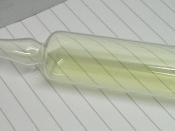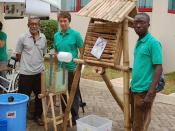Chlorine
Chlorine is (at room temperature) a greenish-yellow gas that can be readily liquefied at 5170 Tarr or 6.8 atmospheres, at 20 C (68 F), and has a very disagreeable odor. It's Element Symbol is Cl, atomic number is 17, and atomic mass is 35.453. Chlorine's melting point is -101 C or 149.8 F. The boiling point is -34.05 C or -29.29 F, at one atmosphere pressure. Chlorine is a member of the halogen group. Chlorine was discovered by Swedish scientist Karl Wilhelm in 1784, but he first thought it was a compound, rather than an element. In 1810, Sir Humphrey Davy named it Chlorine, from the Greek word meaning 'greenish-yellow'.
Chlorine is used in bleaching agents, disinfectants, monomers (plastics), solvents, and pesticides. It is also used for bleaching paper pulp and other organic materials, preparing bromine, (a poisonous element that at room temperature is a dark, reddish-brown), tetraethyl lead, and killing germs in water, particularly in swimming pools and hot tubs.
Like every member of the halogen group, chlorine has a tendency to gain one electron and become a chloride ion. Chlorine strongly reacts with metals to form mostly water-soluble chlorides. Chlorine also strongly reacts with nonmetals such as sulfur, phosphorus, and other halogens. If you were to mix hydrogen and chlorine gases and keep them in a cool dark place, the mixture would be stable, but if it were exposed to sunlight, it would cause a strong explosion. If a burning candle were placed in a sealed container of chlorine, it would keep burning, and it would produce thick, black, smoke, leaving behind soot. There are five oxides that chlorine can form: chlorine monoxide; dichloride monoxide; chlorine dioxide; chlorine heptoxide; and chlorine hexoxide.
Chlorine is used in bleaching agents, disinfectants, monomers (plastics), solvents, and pesticides. It...


